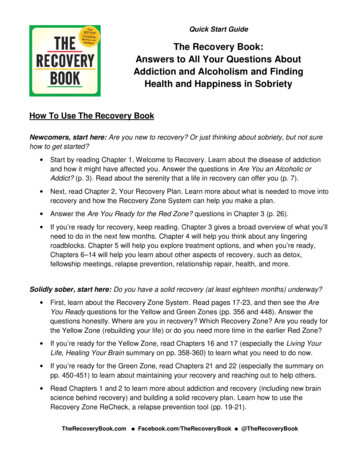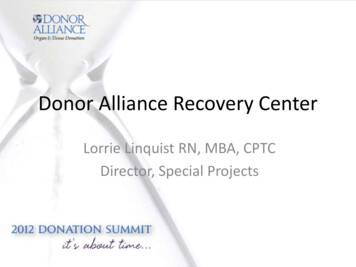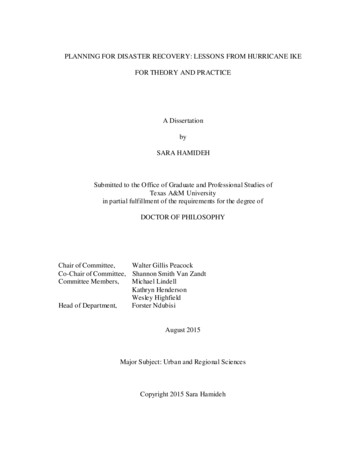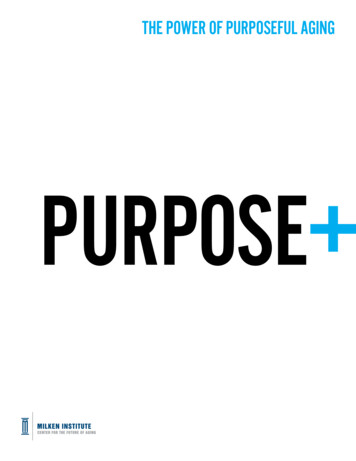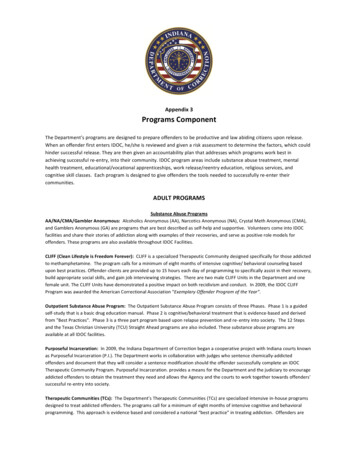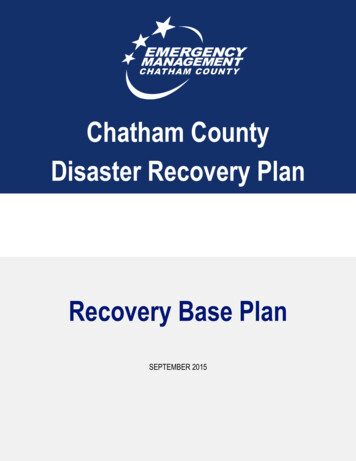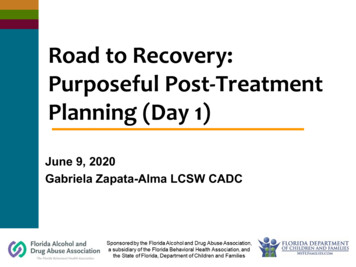
Transcription
Road to Recovery:Purposeful Post-TreatmentPlanning (Day 1)June 9, 2020Gabriela Zapata-Alma LCSW CADC ncdvtmh
Presenter InformationGabriela Zapata-Alma,LCSW, CADCDirector of Policy and Practice onDomestic Violence andSubstance Use, NCDVTMHGZapata.Alma@ncdvtmh.org ncdvtmh
US DHHS ACF FVPSA-Funded Special IssueResource Center Dedicated to Addressing theIntersection of Domestic Violence, Trauma,Substance Use and Mental Health Comprehensive Array of Training & TechnicalAssistance Services and Resources Research and Evaluation Policy Development & Analysis Public Awareness ncdvtmh
The National Center on Domestic Violence, Trauma &Mental Health is supported by Grant #90EV0437-01-00from the Administration on Children, Youth and Families,Family and Youth Services Bureau, U.S. Department ofHealth and Human Services. Points of view in thisdocument are those of the presenters and do notnecessarily reflect the official positions or policies of theU.S. Department of Health and Human Services.
Learning Objectives Describe key elements of continuingrecovery planning Identify trauma-informed dischargepractices and aftercare services forindividuals with substance usedisorders, survivors of domesticviolence and other trauma ncdvtmh Become familiar with RecoveryManagement Checkups as a corecomponent of aftercare services
Today’s Agenda9:00 – 10:30 am Post‐Treatment Planning10:30 – 10:45 am Break10:45 – 12:15pm Continued Recovery Planning12:15 – 12:30 pm Wrap up, Q&A, evaluations ncdvtmh
When do you beginpost-treatment planning? ncdvtmh
Why areposttreatmentplanningandaftercareimportant? ncdvtmh
The Importance ofPost-Treatment PlanningConnection withongoingcommunity-basedrecovery support isassociated withbetter recoveryoutcomes. ncdvtmh(Miller et al. 1997; Ritsher et al. 2002)
The Importanceof Aftercare ServicesAftercareservices havebeen found tosupport recoverymaintenance,even services assimple as phonebased check-ins. ncdvtmh(McKay et al., 2005)
CombiningPost-Treatment Planningand Aftercare ServicesA study found thatpeople who participatedin both communityrecovery support andaftercare services hadbetter long-termrecovery outcomes thanthose who onlyaccessed one. ncdvtmh(Fiorentine & Hillhouse, 2000)
What’s Our Role inPost-Treatment Planning?Providers play a key role in preparingindividuals for treatment end through: individualized planning linking to community resources facilitating transitions actively supporting early engagement incommunity-based recovery support ncdvtmh(CSAT/SAMHSA TIP 47, 2006)
Best Practices inPost-Treatment Planning Start Early Ongoing Planning ContinuingRecovery Planning Continuity of Care ncdvtmh
Start EarlyBegin posttreatmentplanningduringintake ncdvtmh
Start Early 2How will we know when treatment (orthe level of care) is complete? Indicators are defined collaborativelyand mutually understandable. What are the data sources for theseindicators? ncdvtmh
Start Early 3Supports transparency,consistency, andpredictability, whilesupporting autonomywithin services - allessential aspects oftrauma-informedapproaches ncdvtmh
Ongoing Planning Identify neededresources andfacilitate access topotential communityresources/partnersearly in the process Continue reviewingand updating asneeds emerge andevolve ncdvtmh
Who is Involved in PostTreatment Planning? Person accessingservices Their safe socialsupports (asdefined by AND ifdesired by theperson) Treatment team ncdvtmh
Elements of SuccessfulPost-Treatment Planning Individualized Comprehensive Puts together a well-coordinatedsystem of continuous support Access to community resources Community reintegration “ practical and realistic andmaximize available communityresources for the benefit of theclient.” ncdvtmh Continuing recovery planning(Baron et al., 2008)
Post-Treatment Planning:Considerations by Level of Care ncdvtmh(American Society of Addiction Medicine - ASAM)
Post-Treatment Planning:Withdrawal Management (WM) WM is available at every level of care (WM alone isnot considered treatment) Ongoing recovery support is critical for thosecompleting WM services WM-alone for opioids (without stabilization andlinkage to ongoing MAT) has been found to beincrease risk of fatal overdose (Strang et al. 2003) MAT for opioid use disorder to essential – referralsare not enough to ensure continuous access. Overdose prevention education, naloxonedistribution, and ongoing access to naloxone ncdvtmho Resource: www.ISaveFL.com
Detox & Discharge:Fred’s Story ncdvtmh
1. Fred’s Story:What could have theprovider done differently? ncdvtmh
Fred’s Story:Large Group Debrief ncdvtmh
Post-Treatment Planning andWithdrawal Management:Promising Practices Hospital-based buprenorphine induction(Liebschutz et al., 2014) Bridge MAT/MAR clinics (Sigmon et al., 2015) Recovery coaching and peer-based support(Scott et al., 2018) Active service linkages (‘warm handoffs’)(Duber et al., 2018) ncdvtmh Seamless care coordination across settings(services follow the person) (Kirk et al. 2013)
Pause ncdvtmhplease return in 15 min
Post-Treatment Planning:Inpatient/Residential to OutpatientWhat’s important toconsider during posttreatment planningwhen someone iscompletinginpatient/residentialservices? ncdvtmh
Post-Treatment Planning:Inpatient/Residential to Outpatient Safety needs Engagement in stepdown outpatient care Housing and vocationalsupport Recovery supportnetwork Recovery support forfamily ncdvtmh Community reintegration
2. Marcy’s Story: SupportivePost-Treatment Planning ncdvtmh
Marcy’s Story:Large Group Debrief ncdvtmh
Marcy’s Story:A Success Story ncdvtmh
Pause ncdvtmhplease return in 15 min
ContinuingRecoveryPlanning ncdvtmh
Continuing Recovery Planning (CRP) Flows from dynamic treatment planning Main goals of Continuing Recovery Planning: Maintain treatment gains Support greater life goals/needs Recovery capital (both internal andexternal resources) Aftercare planning ncdvtmh
CRP: Maintain Treatment Gains Individualized coping toolbox (cravings/cues) Anticipating situations that present a high riskto recovery gains, including strategies to avoid and/or preventescapecopeengage recovery supports Recovery setback response plan ncdvtmh
Sample: CRP for Risk-toRecovery SituationsIf I encounter a high-risk situation: ncdvtmh I will leave the situation and/or environment. I will put off the decision to use for 15 minutes. I willremember that most cravings are time-limited and Ican ride it out. I will recognize my thoughts as thoughts, notabsolute facts. Do I really need to use? Not likely. Iwill remind myself that my only true needs are for air,water, food, and shelter. I will think of something unrelated to using. I will remind myself of my successes to this point. I will call my list of emergency numbers.(NIAAA, 2003)
Sample: RecoverySetback Response Plan1. Get rid of the substance(s).2. Get away from the place where I used.3. Read this aloud: One use or even one day of usedoes not have to result in a relapse. I will not give into feelings of guilt or shame because I know thesefeelings will pass in time. I can get through this.4. Call a recovery support for help. ncdvtmh5. I will examine this use with my counselor (orRecovery Coach or sponsor), identify cues and myreaction to them. I will update my plan so that I willbe able to cope with a similar situation in the future.REMEMBER: THIS IS ONLY A TEMPORARY(NIAAA, 2003)DETOUR ON THE ROAD OF RECOVERY
CRP: Greater Life Goals / Needs What’s most important for the individual,what are their greater life goals? How does continuing recovery fit in with theirgreater life goals? What remaining needs exist and how can weplan for them? What specific actions are needed in order tosatisfy any court/legal mandates? (if applicable) ncdvtmh
CRP: Recovery Capital The collection of internal and externalsupports a person can access that aid in thejourney of recovery (White & Cloud, 2008) Community-based support resources Recovery-oriented social supports Core values and how they fit in with theirexperience of recovery and recovery goals ncdvtmh
rsonalvaluesRecoveryCapitalSOCIALFamily, intimaterelationships,kinship, socialsupports ncdvtmh(White & Cloud, 2008)PHYSICALPhysical health,safe shelter,basic ery rolemodels, peer-ledsupport groups
CRP: Aftercare Planning How can the treatment provider supportthe individual’s continuing recovery andpursuit of greater life goals? What aftercare services are available? How would the individual like toincorporate available aftercare servicesinto their overall continuing recoveryplan? ncdvtmh
3. Continuing RecoveryPlanning: Marcy’s Next Chapter ncdvtmh
Marcy’s Story:Large Group Debrief ncdvtmh
Challengesin Post-Treatment Planning Increased anxietyabout end of treatment Difficulty anticipatingpost-treatment needs Lack of communityresources Lack of establishedprotocols and training ncdvtmh(Baron et al., 2008 ; SAMHSA TIP 51, 2009)
How Can Organizations SupportPost-Treatment Planning? ncdvtmh Written post-treatment planning protocolStandardized planning formsTraining for all staff involved in planningReview upcoming treatment closures and posttreatment plans in clinical staffingCultivate community resourcesRoutine review of clinical records to provide coachingand feedback for staffRoutine review of protocols to improve theireffectivenessWritten protocols and staff support to provide posttreatment care coordination and collect follow up dataCollect/analyze follow-up data(Baron et al., 2008)
Wrap Up ncdvtmh Check-out (type in chat) - an idea forhow to support long-term recoverythat was inspired by today’s session. Please be sure to complete theevaluation for today (each day hasits own evaluation). Tomorrow we’ll talk about continuityof care and aftercare services – seeyou then!
Resources Faces and Voices of Recovery (Recovery CommunityOrganizations and Mutual Aid):https://facesandvoicesofrecovery.org/ SAMHSA’s Treatment Locator:https://findtreatment.samhsa.gov/ Florida Coalition Against Domestic Violence:https://www.fcadv.org/ Florida Association of Recovery Residences:https://farronline.org/ ncdvtmh Florida Division of Vocational Rehabilitation:http://www.rehabworks.org/
References 1Baron, M, Erlenbusch, B, Moran, CF, O’Connor, K, Rice, K, & Rodriguez, J. (2008). Best PracticesManual for Discharge Planning. Los Angeles Coalition to End Hunger & Homelessness.Center for Substance Abuse Treatment (CSAT/SAMHSA). (2000). Comprehensive Case Managementfor Substance Abuse Treatment. Treatment Improvement Protocol (TIP) Series, No. 27. HHSPublication No. (SMA) 15-4215. Rockville, MD: Center for Substance Abuse Treatment.Center for Substance Abuse Treatment (CSAT/SAMHSA). (2006). Substance Abuse: Clinical Issues inIntensive Outpatient Treatment. Treatment Improvement Protocol (TIP) Series 47. DHHSPublication No. (SMA) 06-4182. Rockville, MD: Substance Abuse and Mental Health ServicesAdministration,. Retrieve from: ment/sma13-4182.pdfCoughey, K, Feighan, K, Cheney, R, & Klein, G. (1998) Retention in an Aftercare Program forRecovering Women, Substance Use & Misuse, 33:4, 917-933, DOI:10.3109/10826089809056249Duber, HC, Barata, IA, Cioe-Pena, E, Liang, SY, Ketcham, E, Micias-Konstantopoulos, W, Ryan, SA,Stavros, M, & Whiteside, LK. (2018). Identification, management, and transition of care forpatients with opioid use disorder in the emergency department. Annals of Emergency Medicine,72(4), p420-431. iorentine, R., & Hillhouse, M. (2000). Drug Treatment and 12-Step Program Participation: The AdditiveEffects of Integrated Recovery Activities. Journal of Substance Abuse Treatment, 18(1), p.65. ncdvtmh
References 2Goldman-Mellor, S., Olfson, M., Lidon-Moyano, C., & Schoenbaum, M. (2020). Mortality following nonfatal opioidand sedative/hypnotic drug overdose. American Journal of Preventive Medicine.Kaplan, L., The Role of Recovery Support Services in Recovery-Oriented Systems of Care. DHHS Publication No.(SMA) 08-4315. Rockville, MD: Center for Substance Abuse Treatment, Substance Abuse and MentalHealth Services Administration, %20Support%20Services.pdfKirk, Thomas & Leo, Paul & Rehmer, Patricia & Moy, Samuel & Davidson, Larry. (2013). A Case and CareManagement Program to Reduce Use of Acute Care by Clients With Substance Use Disorders. Psychiatricservices (Washington, D.C.). 64. 491-3. 10.1176/appi.ps.201200258.Liebschutz, J. M., Crooks, D., Herman, D., Anderson, B., Tsui, J., Meshesha, L. Z., Dossabhoy, S., & Stein, M.(2014). Buprenorphine treatment for hospitalized, opioid-dependent patients: a randomized clinicaltrial. JAMA internal medicine, 174(8), 1369–1376. ay JR, Lynch KG, Shepard DS, Pettinati HM. The Effectiveness of Telephone-Based Continuing Care forAlcohol and Cocaine Dependence: 24-Month Outcomes. Arch Gen Psychiatry. rchpsyc.62.2.199Moran, G, Semansky, R, Quinn, E, Noftsinger, R, & Koenig, T. (2005). Evaluability Assessment of DischargePlanning and the Prevention of Homelessness. US DHHS Office of the Assistant Secretary for Planningand Evaluation. Retrieve from: s ncdvtmhNational Institute of Alcohol Abuse and Alcoholism (NIAAA) (2003). Cognitive Behavioral Coping Skills TherapyManual. Project Match Series (3). Retrieve tmatch/match03.pdf
References 3Scott, CK, Dennis, ML, & Foss, MA. (2005). Utilizing Recovery Management Checkups to Shorten the Cycle ofRelapse, Treatment Reentry, and Recovery. Drug and Alcohol Dependence, 78(3), p.325-38.Scott, CK, & Dennis, ML. (2009). Results from Two Randomized Clinical Trials Evaluating the Impact of QuarterlyRecovery Management Checkups with Adult Chronic Substance Users. Addiction, 104(6), p.959-971.Scott, C.K., Dennis, M.L., Willis, B., & Nicholson, L. (2013). A decade of research on recovery managementcheckups. In: Interventions for addiction: Comprehensive addictive behaviors and disorders. Elsevier Inc.,San Diego: Academic Press, pp. 267–273.Scott, C. K., Grella, C. E., Nicholson, L., & Dennis, M. L. (2018). Opioid recovery initiation: Pilot test of a peeroutreach and modified Recovery Management Checkup intervention for out-of-treatment opioidusers. Journal of substance abuse treatment, 86, 30–35. https://doi.org/10.1016/j.jsat.2017.12.007Sigmon, S. C., C Meyer, A., Hruska, B., Ochalek, T., Rose, G., Badger, G. J., Brooklyn, J. R., Heil, S. H., Higgins,S. T., Moore, B. A., & Schwartz, R. P. (2015). Bridging waitlist delays with interim buprenorphine treatment:initial feasibility. Addictive behaviors, 51, 136–142. , J., McCambridge, J., Best, D., Beswick, T., Bearn, J., Rees, S., & Gossop, M. (2003). Loss of toleranceand overdose mortality after inpatient opiate detoxification: follow up study. BMJ (Clinical researched.), 326(7396), 959–960. doi:10.1136/bmj.326.7396.959Substance Abuse and Mental Health Services Administration. (2009). Substance Abuse Treatment: Addressingthe Specific Needs of Women. Treat ment Improvement Protocol (TIP) Series, No. 51. HHS Publication No.(SMA) 13-4426. Rockville, MD: Substance Abuse and Mental Health Services Administration. ncdvtmhWhite, W. & Cloud, W. (2008). Recovery capital: A primer for addictions professionals. Counselor, 9(5), 22-27.Retrieve from apitalPrimer.pdf
Gabriela Zapata-Alma LCSW, CADCDirector of Policy and Practice on Domestic Violence and Substance UseP: 312-726-7020TTY: nterdvtraumamh.orgTwitter: @ncdvtmhInstagram: @ncdvtmhFacebook: facebook.com/ncdvtmh ncdvtmh
Thank You! ncdvtmh
Question & Answer ncdvtmh
Comprehensive Puts together a well-coordinated . Center for Substance Abuse Treatment (CSAT/SAMHSA). (2000). Comprehensive Case Management for Substance Abuse Treatment. Treatment Improvement Protocol (TIP) Series, No. 27. HHS Publication No. (SMA) 15-4215. Rockville, MD: Center for Substance Abuse Treatment. Center for Substance Abuse .




